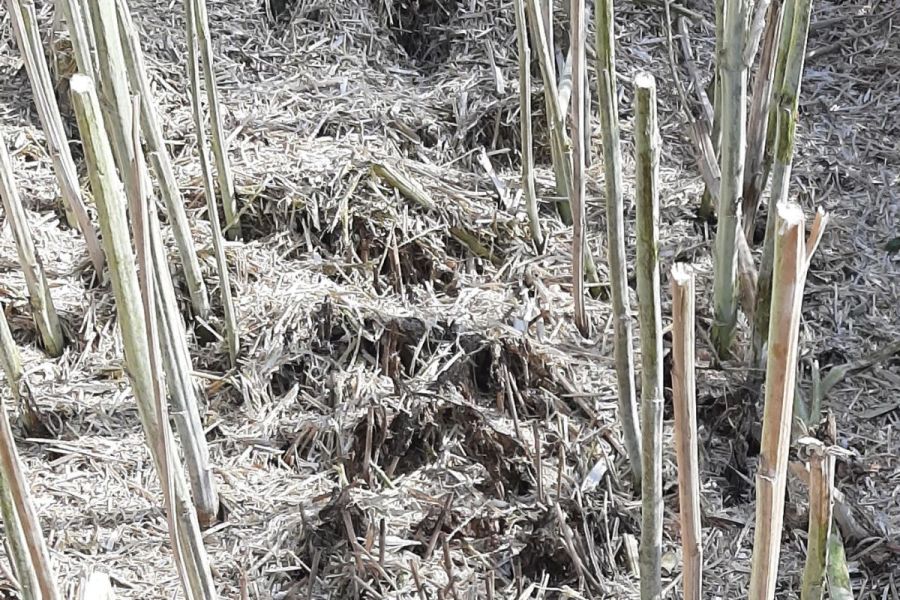Innovation isn’t always about light bulb moments, sometimes it’s a case of joining the dots. CPM gets an insight onto how an oilseed rape plant breeder discovered genetics with resistance to verticillium.
“Breeding is the main weapon we have against the disease.”
By Melanie Jenkins
Breeding disease resistance into new plant varieties has become vitally more significant as access to the arsenal of pesticides gradually tightens and pressures mount for a more holistic approach to integrated pest management. And in some cases, no pesticide options are available at all.
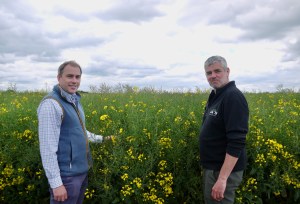
Chris Guest and Craig Padley both feel that the impact of verticillium may be overlooked if farmers haven’t grown oilseed rape for several years.
One of those diseases is verticillium, originally named verticillium wilt but renamed in 2016 to verticillium stem stripe due to lack of wilting symptoms in OSR, clarifies Christian Flachenecker, NPZ winter oilseed rape breeder.
“Breeding is the main weapon we have against the disease and is a high priority for breeders as there’s no fungicide control against verticillium,” he stresses.
Although not a new disease, it’s history in the UK is relatively recent. OSR was first recognised as a host of verticillium stem stripe in Sweden in 1969 but the disease has only been officially recognised in the UK since 2007, explains LSPB’s Craig Padley.
“The first plant material I saw with verticillium was at the OSR congress in Copenhagen in 2003 and I first experienced the disease in the UK at local trials in 2009.”
For LSPB, verticillium has become an increasing issue at the firm’s trial site north of Cambridge, says Craig. “Our typical rotation has OSR one in five and even then, we’re still seeing issues. For the past two to three years, we have been protecting our local trials from cabbage stem flea beetle and this has allowed us to identify a correlation between verticillium resistance and yield, with some popular varieties with high levels of resistance yielding 20-25% lower than expected when compared with the AHDB Recommended List.”

No single gene has yet been identified that provides significant resistance against verticillium, according to Christian Flachenecker.
But verticillium resistance has proven to be particularly hard to breed for compared with some other OSR diseases. However, LSPB has produced several innovative new varieties with good quantitative resistance to the disease, with one topping the RL, says Chris.
This came about as part of a wider company aim started by LSPB’s parent firm NPZ. “Once verticillium was identified as an issue, the company wanted to start screening for it in the breeding programme,” explains Craig.
“The island of Fehmarn in the Baltic Sea had high levels of the disease in the soil making it ideal as a trial site. So we’ve been screening there since 2010 as we can get repeatable scores. From this work, we have been able to identify several lines with good resistance to verticillium and these have been developed for our current and future hybrid offering.”
But even on the island, verticillium symptoms aren’t strong every year, says Christian. So further work has since been done to develop a bioassay in glasshouses, which has given more repeatable results and allowed the firm to supplement its field screening with additional glasshouse trials.
The firm is routinely screening its hybrids for resistance and has pre-breeding activities undergoing to identify novel sources of resilience to verticillium and other diseases, add Craig.
Research has also involved looking at exotic materials related to OSR, such as cabbage, to try to identify resistant genes, says Christian. “But no single gene has yet been identified that provides significant resistance against verticillium, which has meant it’s been incredibly hard to breed varieties with quantitative resistance to it.

LSPB has produced several innovative new varieties with good quantitative resistance to verticillium.
“We have looked for one, and there were some hints that there could have been promising genetics in related brassicas, but there’s never been a major resistance gene found. If we discovered one then we’d be able to develop a marker for it, but this still isn’t possible with verticillium which is why field screenings and bioassay testing it so important,” he explains.
“What we believe we have at the moment is a number of genes working together to provide quantitative resistance to the disease.”
LSPB’s latest variety, Turing, has demonstrated a high level of resistance to verticillium and has topped the UK RL for gross output, at 107%, according to Christian.
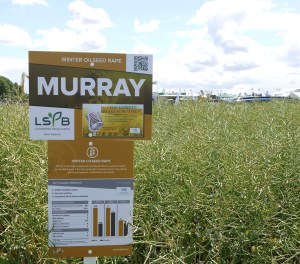
LSPB’s variety Murray has demonstrated good resistance to verticillium.
Murray – with 106% on the RL for the East/West region only – is another variety which has demonstrated good resistance to verticillium, while Vegas – 105% UK gross output on the RL – has medium resistance.
“With all three of these varieties, growers don’t need to fear verticillium too much as they’re among the best on the market for resistance,” says Christian. “Our Cambridgeshire site had the hardest attack by verticillium last year it had experienced for three or four years and both Turing and Murray coped with it.”
One thing NPZ/LSPB has noticed in its breeding programme is that a good verticillium resistance also prevents pod shattering, notes LSPB’s Chris Guest. Although this is anecdotal, he comments that despite LSPB’s hybrids currently not having the pod shatter resistance gene, they still perform very well under field conditions due to their healthy throughout the groing season, particularly in the latter stages.
But while breeders continue to look for more advanced solutions to the disease, the advice is to spread risk, says Chris. “It’s about managing the genetics that are on offer and not over-utilising or relying on a specific variety. We’ve seen the OSR area pick back up for the coming harvest and I feel it’ll go up again next year, so consider verticillium resistance as a selecting factor for the autumn.”
Being aware of the disease’s presence means growers can plan for it, adds Craig. “If it’s in your soils, you ought to consider growing varieties that are more resistant.”
LSPB is now trying to combine verticillium resistance with other disease resistances, says Christian. “In Turing and Murray, this is combined with light leaf spot resistance. But because of the lack of a marker for verticillium resistant genes, it’s very hard.
“Even with the development of gene editing and CRISPR-Cas9, it’s not possible to identify resistance genes, so we have to keep working on a broad basis and continue with our classical breeding efforts,” he adds.
The hidden thief

Philip Walker says that there are certain varieties which do have resistance mechanisms against verticillium.
Although the highest incidences of the disease are historically seen in the East and central England, says Craig, verticillium has spread far and wide, having been recorded as far west as Herefordshire and north into Yorkshire.
So why is it becoming more widespread? ADAS plant pathologist, Philip Walker explains more about the disease. Caused by the pathogen Verticillium longisporum, it’s a soil borne disease which – a bit like club root – can survive for up to 10 years or longer in the soil, he says.
“So once you have it, verticillium is there for a long time – the disease is very persistent.
“The fungus survives as microsclerotia on the previous crop debris. When the next OSR crop is planted, the root exudates stimulate the germination of the fungus which then penetrates the root hairs, surviving in the plant tissue asymptomatically for a long time,” he says.
“When a crop goes through stem extension, the fungus grows into the vascular system and is transported to other plant tissues. A few weeks before harvest, brown striping on the stems become visible,” describes Philip. Now the fungus invades from the vessels and starts to damage surrounding plant parenchyma, leading to senescence and finally the formation of microsclerotia beneath the epidermis.
In contrast, this systemic spread of the fungus at the early plant growth stages is reduced in plants which exhibit resistance to the disease.
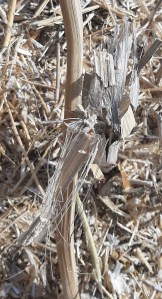
Post-harvest verticillium can be seen in the stems as black striping.
The main issue verticillium causes in OSR is a premature ripening of the plant pre-harvest, explains Craig. “Like phoma stem canker, verticillium switches at one point in its lifecycle to a destructive phase and compromises plant stem performance, leading to reduced thousand seed weight and therefore yield.
“Pre-harvest the disease displays as striping on the stems and branches, as well as premature pod senescence – they turn black, and seeds don’t develop. Post-harvest it can be seen in the stems as black striping.”
And with the disease still being relatively new to the UK, there’s a concern that the symptoms pre- and post-harvest may be going unidentified, suggests Craig. “We have known growers with promising looking crops that have failed to deliver on expectations, so we’re encouraging agronomists to look at the stems to see if verticillium is present. NIAB can soil test for the disease, but once you know the symptoms it’s fairly distinctive.”
Capable of robbing growers of up to 30% of their yield, losses from verticillium may not be inconsiderable, adds Chris.
And in 2017, the Defra pest and disease survey estimated that around 20% of the UK’s OSR cropping had some form of infection, adds Craig. “And I’m pretty sure it has increased since then. The reason being that there’s a prominent movement towards min and no-till practices, which means trash is left on the surface of the soil and could be helping it spread.
“And going back 10 years or so, a lot of growers had quite tight rotations, which may also have exacerbated the issue by feeding the fungus.”
Christian also believes that climate change is helping the disease. “We have found that higher temperatures in the autumn leads to conditions more conducive to infection. Warmer autumns might be good for growers as it means they can drill later and still get good establishment but on the other hand this exacerbates fungal diseases such as verticillium.”
It’s also a disease which hasn’t had a lot of work done on it for quite some time, according to Chris. “A lot of the information out there is based on older research but AHDB is doing some work on establishing an index scoring system, however this isn’t publicly available yet. So far, there’s one year’s worth of data and they require two years of data before they can rate the varieties and publish the information on the RL.”
ADAS has been running variety screening trials to identify verticillium resistance for the past 10 years, says Philip. “We know certain varieties do have resistance mechanisms against verticillium spores growing in stem tissues, so they don’t express symptoms, essentially preventing infection. An index score from 1-100 is allocated to varieties based on assessment pre-harvest with the most susceptible varieties scoring 90 or above and those more resistant scoring about 30. We find our assessment method is very reliable in confidently discriminating between the varieties for verticillium.”
A view from the field
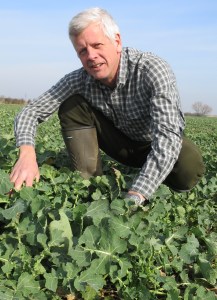
In trials, David Leaper says the resistance to verticillium was noticeable in LSPB varieties.
As many growers return to oilseed rape for what might be the first time in a number of years, they’re being advised to not forget the lurking dangers to yield posed by verticillium stem stripe. This sly disease is known to sit in soils for years and though it may infect plants in autumn, will silently damage the plant’s systems throughout the season, only evident through physical symptoms immediately pre-harvest – meaning it can go undetected, warns Chris Guest of LSPB.
“OSR growers have been through quite a few challenges in the past two years, including drought and cabbage stem flea beetle – especially those in East Anglia and the southeast of England – while others had gone away from the crop altogether and therefore may have forgotten about the silent killer that’s verticillium,” he says.
The proof of the pudding is always in the eating. That’s one of the reasons why Agrii puts varieties through their paces to get an insider’s view.
David Leaper’s assessment of Agrii’s trial sites last year highlights the advances in resistance to the disease in LSPB varieties. “Turing, Vegas and Flemming demonstrated very clean stem health towards the end of the season with low levels of verticillium symptoms. This was in contrast to other hybrids, which, although still high yielding, had high levels of symptoms,” he explains.
He also suggests that growers shouldn’t be put off by the lack of turnip yellow virus resistance in the LSPB varieties. “They generally have good disease resistance and are yielding at the top end. So even though they don’t have the full traits package, they’re still bringing a great deal to the party.”
Prior to verticillium being formally identified in the UK, its symptoms tended to be masked by other diseases, adds David. “Now, I find one pair of eyes late in the season can get consistent information on it. And while some argue that opening up rotations help, it still tends to feature later in the season, especially if there’s stress on the plants from things such as drought conditions.”
The stealthy nature of verticillium is something growers should be very aware of, suggests Chris, especially if they’re returning to OSR for the first time in a number of years. This sly disease is known to sit in soils for years and though it may infect plants in autumn, will silently damage the plant’s systems throughout the season, only evident through physical symptoms immediately pre-harvest – meaning it can go undetected.
Innovation Insight
CPM would like to thank LSPB for kindly sponsoring this article, and for providing privileged access to staff and material used to help put the article together.
This article was taken from the latest issue of CPM. For more articles like this, subscribe here.

